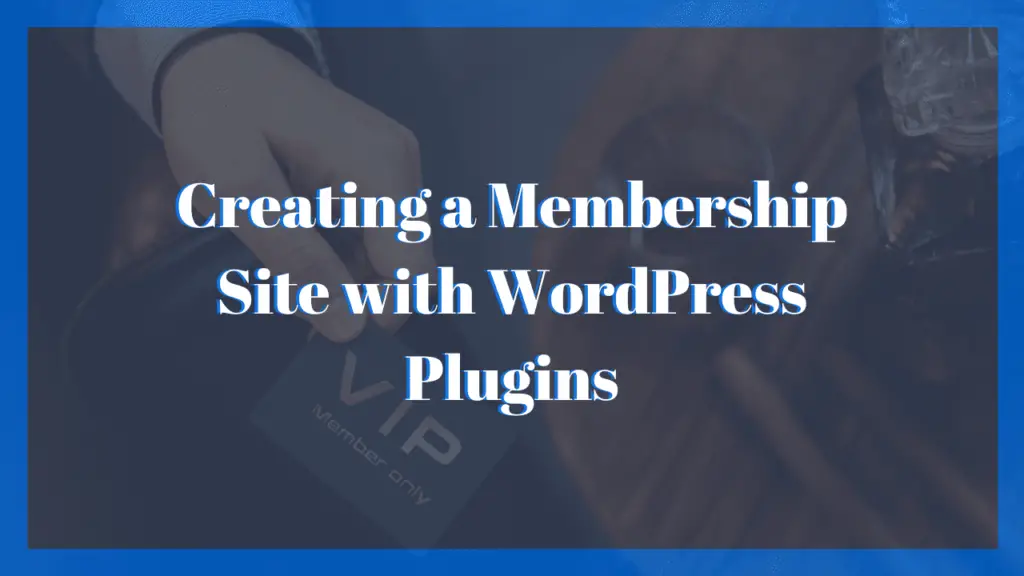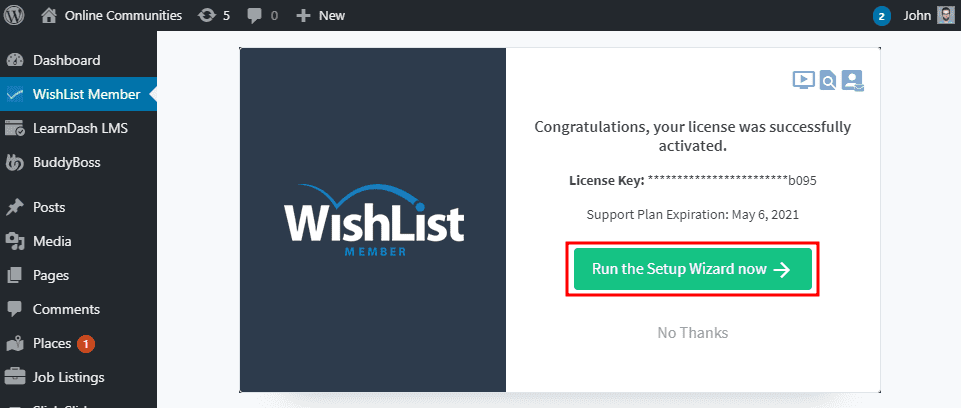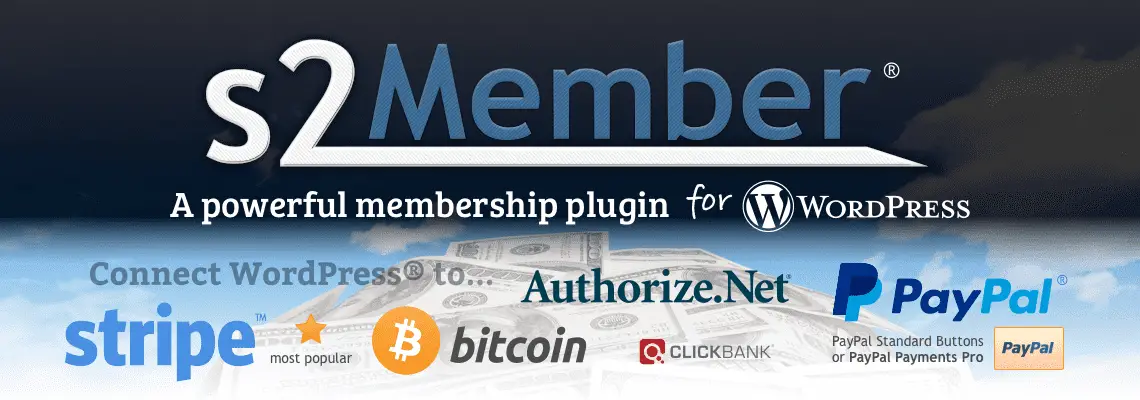Creating a Membership Site with WordPress Plugins 2024

Are you eager to unlock the full potential of your website, captivate your audience, and establish a reliable income stream? If the answer is yes, the solution you’ve been seeking could be found in creating a membership site. The essence of a membership site lies in providing exclusive content or services to paying members, making it an ideal avenue for generating recurring revenue and cultivating a dedicated community around your brand.
Embarking on the journey of membership site creation presents an excellent opportunity to deliver unparalleled exclusive content, foster a loyal community, and effectively monetize your online presence. Within this comprehensive guide, we will illuminate the path to achieving these goals and more, leveraging the formidable capabilities of WordPress plugins.
The Power of Membership Sites (Why You Need One?)
Before we dive into the nitty-gritty of setting up your membership site, it’s crucial to understand why you need one in the first place. Membership sites have become a game-changer for businesses, content creators, and organizations of all sizes.
Imagine having a dedicated group of members eager to access your premium content and willing to pay for it regularly. This creates a consistent revenue stream that can be a game-changer for your business.
Here are some compelling reasons why you should consider creating a membership site:
1. Exclusive Access: With a membership site, you can provide members with exclusive content, whether it’s premium articles, downloadable resources, videos, webinars, or online courses. This exclusivity can significantly enhance the perceived value of your offerings.
2. Community Building: Membership sites foster a sense of community among your audience. Members can interact with each other, share experiences, and form meaningful connections, turning your website into a hub for like-minded individuals.
3. Steady Income: You can establish a steady income source by charging a subscription fee. Over time, this can help you reduce the unpredictability of your revenue, making financial planning much more straightforward.
4. Brand Loyalty: A valuable membership experience can increase brand loyalty and trust. Your members are more likely to become your most dedicated fans and advocates.
5. Valuable Data: Membership sites can provide valuable data and insights into your audience’s behavior and preferences. This information can inform your content strategy, product development, and marketing efforts.
Choosing the Right WordPress Membership Plugin
Choosing a WordPress membership plugin is an important decision, as it will affect the features and functionality of your membership site. When choosing a plugin, it is important to consider your needs and budget. There are several factors to consider, including:
Features: What features are important to you? Do you need a plugin that can support multiple membership levels? Content dripping? Payment gateways? Email integration?
Ease of use: How easy is the plugin to use? If you are not tech-savvy, you will want to choose a plugin that is easy to set up and manage.
Price: WordPress membership plugins can range from free to hundreds of dollars. Choose a plugin that fits your budget and needs.
Support: Does the plugin offer good support? If you run into problems, you want to be able to get help quickly and easily.
Community: Does the plugin have a large and active community? This can be a valuable resource for getting help and troubleshooting problems.
Setting Up Your WordPress Membership Site
Now that you have carefully selected the WordPress membership plugin that aligns with your goals, it’s time to begin setting up your membership site. The following steps will guide you through the process:
1. Create Membership Levels
Creating distinct membership levels is crucial in tailoring your WordPress membership site to your audience’s varied preferences and needs. Each membership level is a tiered offering, providing different benefits, access, and pricing plans. Here’s a detailed guide on how to effectively create membership levels:
Define Your Membership Tiers: Start by clearly defining the types of membership levels you want to offer. Consider factors such as the depth of content access, exclusivity, and any additional perks you plan to provide. For example, you might have basic, premium, and VIP levels.
Determine Pricing Plans: Assign specific pricing plans to each membership level. Consider your value at each tier and align the pricing with the perceived benefits. This could involve a monthly subscription, annual payment, or any other pricing structure that fits your business model.
Outline Access and Benefits: Clearly outline the benefits and access associated with each membership level. This might include access to premium content, exclusive forums, downloadable resources, member-only events, or any other perks that differentiate one group from another.
Consider Trial Periods or Free Memberships: You may offer trial or free memberships to attract potential members and encourage sign-ups. This allows users to experience the value of your membership site before committing to a paid subscription.
Set Content Drip: Configure content drip settings for each level if your content strategy involves a staged release of materials over time. This ensures a continuous and engaging experience for your members, keeping them subscribed for longer durations.
Use Tiered Access Control: Leverage your chosen membership plugin’s access control features to restrict content based on membership levels. Ensure that higher-tier members enjoy access to all content from lower tiers, creating a progressive value proposition.
Test Your Membership Levels: Before launching, consider testing your membership levels with a small audience or focus group. Gather feedback on the perceived value and adjust your offerings accordingly. This iterative process ensures that your membership levels resonate with your target audience.
Create Visually Appealing Badges or Icons: Consider creating badges or icons representing each tier to enhance the visual appeal and recognition of membership levels. These visual cues can be displayed on your site’s member profiles, forum posts, or other relevant sections.
Communicate Clearly on Your Site: Communicate the details of each membership level on your website. This information should be easily accessible to potential members, guiding them in making informed decisions about which tier best fits their needs.
Provide Upgrading/Downgrading Options: Design your membership site to allow members to easily upgrade or downgrade their membership level. This flexibility empowers members to adjust their subscriptions based on changing needs or preferences.
By following these steps, you ensure that your membership levels are thoughtfully crafted to meet the expectations of your audience. A well-structured membership hierarchy enhances user experience, encourages conversions, and lays the foundation for a successful and sustainable membership site.
2. Set Up Payment Methods
You must use your WordPress membership plugin to set up payment methods for your WordPress membership site. Each plugin has its way of setting up payment methods, but the general process is similar.
Evaluate and Choose a Payment Gateway Option: Identify the payment gateways supported by your chosen WordPress membership plugin. Standard options include PayPal, Stripe, Authorize.net, and others. Research each gateway’s features, transaction fees, and user experiences.
Select a primary payment gateway that aligns with your business model and audience preferences. Consider factors such as global accessibility, ease of use, and compatibility with your chosen membership plugin. This will be the main channel through which your members make payments.
Configure Payment Gateway Settings: Once you’ve chosen your primary payment gateway, configure its settings within your membership plugin. This typically involves entering your account credentials, API keys, and other necessary information the payment gateway provides. Follow the plugin’s documentation for specific instructions.
Offer Multiple Payment Options: Enhance the convenience of your members by offering multiple payment options. While a primary gateway is essential, consider providing alternative methods, such as credit/debit cards, in addition to third-party processors like PayPal. This accommodates a broader range of users with varying preferences.
Set Up Recurring Billing (if applicable): If your membership site involves subscription-based plans with recurring payments, ensure that your chosen payment gateway supports recurring billing. Set up the billing frequency (monthly, annually, etc.) and communicate this to your members during the signup process.
Test Transactions: Before making your membership site live, thoroughly test the payment process. Perform test transactions using primary and alternative payment methods to ensure everything functions correctly. This helps identify and address potential issues before members engage in transactions.
Enable SSL Encryption: Security is paramount when handling financial transactions. Ensure your website has an SSL certificate installed and active. This encrypts data transmitted between your site and the payment gateway, protecting sensitive information like credit card details.
Display Clear Payment Policies: Communicate your payment policies on your website, including refund policies, billing cycles, and any additional fees. Transparency builds trust with your members and reduces the likelihood of misunderstandings.
Monitor and Update: Regularly monitor your payment processes and stay informed about updates or changes to your chosen payment gateways. Ensure your plugin and payment gateway integrations remain up-to-date to benefit from the latest features and security enhancements.
Provide Customer Support: Anticipate that members may have questions or encounter payment issues. Provide clear and accessible customer support channels to promptly address inquiries, including contact forms, email addresses, or support forums.
By carefully setting up and managing your payment methods, you streamline the user experience for your members and establish a trustworthy and reliable foundation for your WordPress membership site. This attention to detail contributes to the overall success and sustainability of your membership community
3. Restrict Access to Membership Content:
Ensuring exclusive access to premium content is a cornerstone of a successful membership site. With the right WordPress membership plugin, you gain powerful tools to restrict content access to only those who have subscribed or purchased a membership. Here’s a detailed exploration of how to effectively manage and restrict access to membership content:
Content Protection Strategies: Most WordPress membership plugins provide versatile content protection strategies. These include restricting access to pages, posts, categories, or specific media types. Familiarize yourself with the options your chosen plugin offers.
Setting Access Rules: Define access rules based on membership levels. For example, you may have different tiers of membership, each granting access to a distinct set of content. Your plugin should allow you to configure these rules through a user-friendly interface easily.
Drip Content Release: Drip content release is a powerful engagement strategy where you schedule the release of content over time. This keeps members consistently engaged and encourages them to stay subscribed. Ensure your plugin supports this feature and set up a release schedule aligned with your content strategy.
Protecting Downloads and Resources: If your membership site involves downloadable resources, such as e-books, videos, or documents, ensure your plugin can protect these files. This prevents non-members from accessing or sharing these valuable resources without the proper subscription.
Member-Only Areas: Designate specific areas of your website as “member-only.” This could be entire sections, particular pages, or a members-only forum. Communicate the exclusivity of these areas to incentivize membership sign-ups.
Customizing Access Messages: Customize the messages displayed to non-members when accessing restricted content. This can include prompts to sign up or upgrade their membership for full access. Tailoring these messages enhances the user experience and encourages conversion.
Trial Periods and Free Samples: Some membership plugins allow you to offer trial periods or free samples of your premium content. This can be a compelling way to attract potential members by providing a taste of the exclusive materials they can access with a full membership.
Integrating with E-commerce: If your membership site involves selling products or services, integrate your membership plugin with your e-commerce platform. This ensures a seamless experience for members who may also be customers, with access to their purchased products and exclusive membership content.
Member Directory and Networking: Consider features that facilitate member networking, such as a member directory. While this doesn’t restrict access, it adds value to the membership experience by fostering a sense of community.
Monitoring and Analytics: Use your plugin’s monitoring and analytics tools to track member engagement. Understand which content is resonating the most and adjust your strategy accordingly. Analytics also help identify potential issues, such as high bounce rates on certain pages.
Regularly Update Access Rules: As your membership site evolves, revisit and update access rules. This may involve adding new membership tiers, adjusting content release schedules, or revising access to match the changing needs of your community.
Effectively managing and restricting access to membership content is a dynamic process that requires thoughtful planning and ongoing optimization. By leveraging the features of your chosen membership plugin, you can create a seamless and secure environment for your members while maximizing the value they receive from their subscriptions
4. Create a Pricing Page:
Your pricing page is a critical component of your membership site, serving as a central hub for potential members to understand the value of each membership tier and make informed decisions. Here’s a detailed guide to creating a compelling pricing page:
Clearly Outline Membership Levels: Provide a breakdown of each membership level you offer. Clearly articulate each tier’s features, benefits, and access privileges. Use concise and persuasive language to highlight what makes each level unique.
Pricing Plans and Options: Display pricing plans prominently. Whether it’s a monthly, yearly, or one-time payment structure, visitors can easily compare the costs associated with each membership level. Consider offering discounts for annual subscriptions to encourage long-term commitments.
Feature Comparison Table: Create a feature table for visitors to compare membership levels. Include critical features, access levels, and additional perks each tier offers. This visual representation aids potential members in quickly assessing the value proposition of each level.
Highlight Benefits and Exclusive Content: Communicate the benefits of becoming a member. Detail the exclusive content, resources, or privileges members will gain access to. This could include premium articles, downloadable resources, webinars, community forums, or any other perks unique to your membership site.
Call-to-Action (CTA) Buttons: Strategically place compelling call-to-action buttons throughout the pricing page. Use persuasive language on these buttons, encouraging visitors to take the next step, whether signing up for a free trial or committing to a subscription.
Free Trial or Demo Option: Consider offering a free trial or demo option if applicable. This allows potential members to experience the value of your membership site before making a financial commitment. Clearly outline the trial duration and what’s included during this period.
Transparent Pricing and Terms: Be transparent about your pricing structure and terms. Clearly state any additional fees, renewal policies, or conditions associated with membership. Transparency builds trust and reduces the likelihood of confusion or dissatisfaction among your members.
Testimonials and Social Proof: Boost credibility by including testimonials or social proof on your pricing page. Positive feedback from existing members can instill confidence in potential members, validating the value and satisfaction others have experienced with your membership site.
Visual Elements and Branding: Incorporate visual elements and maintain consistent branding throughout the pricing page. Use high-quality images, your brand colors, and engaging visuals to create an aesthetically pleasing and cohesive user experience.
Mobile Responsiveness: Ensure that your pricing page is optimized for mobile devices. A growing number of users access websites from smartphones and tablets, so your pricing information must be easily navigable and visually appealing across various screen sizes.
FAQ Section: Anticipate and address common questions potential members might have by including a Frequently Asked Questions (FAQ) section. Cover topics like payment methods, cancellation policies, and other relevant queries to enhance user confidence.
Contact Information and Support: Provide clear contact information and support options on the pricing page. This includes customer support email addresses, links to support forums, or other channels where potential members can seek assistance or clarification.
By implementing these strategies, your pricing page becomes a persuasive tool for converting visitors into paying members. Remember, a well-crafted pricing page communicates the value of your membership site and instills trust and confidence in potential members, encouraging them to take the next step in joining your exclusive community.
5. Add Sign-Up and Login Forms:
Creating seamless and intuitive sign-up and login forms is crucial to establishing a user-friendly WordPress membership site. These forms are pivotal in attracting potential members, facilitating account creation, and ensuring secure access to exclusive content. Let’s delve into the detailed steps involved in adding effective sign-up and login forms to your website:
Choose a Location for Forms: Determine strategic placements for your sign-up and login forms. Common locations include the homepage, dedicated membership pages, or a prominent navigation menu. Ensure that these forms are easily accessible and visible to visitors.
Utilize WordPress Membership Plugin Features: Leverage your chosen membership plugin’s features to seamlessly integrate sign-up and login functionalities. Most membership plugins offer dedicated shortcodes or widgets that can be easily inserted into your chosen pages.
Design User-Friendly Forms: Keep the design of your forms simple, clean, and user-friendly. Request essential information during the sign-up process to minimize friction. Fields such as username, email, and password are typically standard.
Customize Form Fields and Labels: Tailor the form fields and labels to align with your branding and user expectations. Communicate the benefits of signing up and joining your membership community to encourage conversions.
Implement a Strong Password Policy: Encourage secure practices by implementing a firm password policy. Provide guidelines on password complexity and length to enhance the security of user accounts.
Enable Social Media Sign-Up Options: Enhance user convenience by incorporating social media sign-up options. This allows users to register using their existing social media credentials, streamlining the onboarding process.
Implement Two-Factor Authentication (2FA): Consider adding an extra layer of security by implementing two-factor authentication (2FA). This additional step, often involving a verification code sent to the user’s email or mobile device, adds extra protection to user accounts.
Offer a Guest Preview Option: Consider providing a guest preview option for visitors to explore a limited portion of your membership content before committing to sign up. This teaser content can entice users to register for full access.
Mobile Responsiveness: Ensure that your sign-up and login forms fully respond to different devices, especially mobile devices. A mobile-friendly design is crucial for capturing users accessing your site on smartphones or tablets.
Test User Experience: Test the sign-up and login process from a user’s perspective. Ensure the forms are intuitive, error messages are clear, and the overall experience is smooth. Identify and address any potential issues that may deter users from completing the registration process.
Capture Analytics for Optimization: Implement analytics tools to capture data on user interactions with your forms. Analyze the data regularly to identify trends, optimize form performance, and enhance the user experience.
Paying meticulous attention to these details and optimizing the sign-up and login process will create a positive first impression for potential members and encourage them to engage with your membership site. The goal is to make the onboarding experience seamless and inviting, setting the stage for a thriving and satisfied membership community.
Membership Site Plugins
Here are 6 membership website plugins that are available on WordPress:
MemberPress:

MemberPress is a highly sought-after WordPress membership plugin offering many features. These include multiple membership levels, content dripping, payment gateways, and seamless email marketing integration. Renowned for its versatility, MemberPress is a powerful plugin well-suited for various membership sites.
Restrict Content Pro:

Recognized for its simplicity and user-friendliness, Restrict Content Pro is a lightweight WordPress membership plugin ideal for straightforward membership sites. Basic yet effective, it provides features such as multiple membership levels, content dripping, and integration with payment gateways. Restrict Content Pro is an excellent choice, especially for beginners seeking a simple, affordable solution.
Paid Memberships Pro:

A popular choice among WordPress users, Paid Memberships Pro offers a comprehensive suite of features, including multiple membership levels, content dripping, payment gateways, and seamless email marketing integration. Its adaptability caters to simple and complex membership sites, making it a powerful and flexible plugin.
Wishlist Member:

Tailored for bloggers and online marketers, Wishlist Member provides features designed specifically for this audience. Noteworthy offerings include the ability to create drip content campaigns and track member engagement. This plugin is a valuable option for bloggers and marketers seeking to grow their audience and generate revenue.
s2Member:

As a free WordPress membership plugin, s2Member offers a fundamental set of features encompassing multiple membership levels, content dripping, and payment gateways. While it is an excellent choice for users seeking a free and straightforward solution, it may not suit those requiring advanced features.
MemberMouse:

Known for its ease of use and seamless integration with other WordPress plugins and services, MemberMouse is a user-friendly WordPress membership plugin. Offering features such as multiple membership levels, content dripping, payment gateways, and email marketing integration, MemberMouse is a versatile and straightforward option.
In Conclusion
Creating a membership site with WordPress plugins is a dynamic strategy for generating recurring revenue, building a vibrant community, and positioning yourself as an authority in your field. Following the steps outlined in this blog post, you can swiftly establish your membership site, unlocking many opportunities.
Key Takeaways:
Choose Wisely: Select a WordPress membership plugin that aligns with your needs and budgetary considerations.
Diversify Membership Levels: Craft membership levels offering diverse pricing plans, perks, and access, catering to the unique preferences of your audience.
Payment Convenience: Streamline the sign-up process by accepting multiple payment methods, making it convenient for members to join your community.
Exclusive Content Access: Enhance the perceived value of your membership by restricting access to premium content to paying members.
Informative Pricing Page: Develop a clear and informative pricing page, guiding potential members on the available plans and benefits.
Seamless Onboarding: Integrate user-friendly sign-up and login forms seamlessly into your website to ensure a smooth onboarding experience.
Effective Promotion: Actively promote your membership site to attract new members, employing strategies such as social media campaigns, email marketing, and more.
We trust that this blog post has provided valuable insights into the intricacies of setting up a membership site. Should you have any queries or seek further guidance, don’t hesitate to leave a comment below.
Continue enhancing your WordPress expertise by exploring our additional blog posts on WordPress Plugins and Cybersecurity. Delve into the wealth of insights and strategies to further fortify your online presence and ensure the continued success of your membership site. Your journey to digital empowerment continues – read on!





